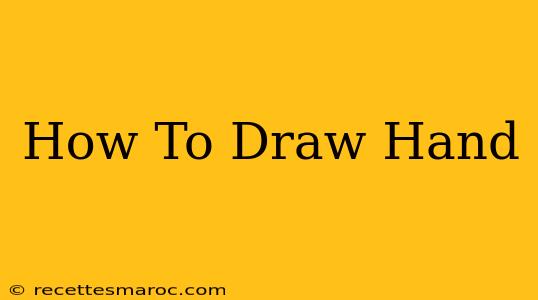Drawing hands can be intimidating, even for experienced artists. They're complex, with many intricate parts and subtle movements. But with the right approach and a little practice, you can master the art of drawing realistic and expressive hands. This guide provides a step-by-step approach, perfect for beginners.
Understanding Hand Anatomy: The Foundation of Realistic Drawing
Before you even pick up your pencil, understanding the basic anatomy of a hand is crucial. Think of the hand as a collection of simple shapes:
- Palm: A broad, slightly rectangular shape forming the base of the hand.
- Fingers: Cylindrical shapes tapering towards the fingertips. Note that each finger has three knuckles (except the thumb, which has two).
- Thumb: A unique finger, positioned at an angle to the other fingers, and possessing a distinct shape.
Think about the way the bones and joints create movement and form. Observing real hands, photographs, or even your own hands will be invaluable.
Step-by-Step Guide to Drawing a Hand
Let's break down the drawing process into manageable steps:
Step 1: Sketching the Basic Shapes
Start with simple shapes. Lightly sketch the palm as a rectangle or trapezoid. Then, add simple cylindrical shapes for each finger, paying attention to their relative lengths and positions. Don't worry about perfection at this stage; it's all about establishing the overall structure. Consider the perspective; is the hand facing you directly, or is it angled?
Step 2: Defining the Knuckles and Joints
Once you're happy with the basic shapes, refine the drawing by adding the knuckles and joints. These are crucial for creating the hand's natural curves and bends. Remember that the knuckles are not perfectly aligned; they're slightly staggered. Observe how they protrude when the hand is clenched or relaxed. Add subtle curves to depict the soft tissue around the joints.
Step 3: Adding Finger Details
Now, focus on the individual fingers. Pay attention to the subtle variations in length and thickness. Each finger is slightly different. Carefully sketch the fingernails, paying attention to their shape and curvature.
Step 4: Refining the Palm and Thumb
Refine the shape of the palm, adding the slight curves and creases that characterize its surface. Pay particular attention to the thumb's unique position and shape. Its flexibility and angle relative to the other fingers are key to making your hand drawing look realistic.
Step 5: Adding Shadows and Highlights
Finally, add shadows and highlights to give your drawing depth and dimension. Observe how light falls on the hand, creating highlights on raised surfaces and shadows in the creases and crevices. This will bring your drawing to life and enhance its realism. Consider using a light source to study the play of light and shadow.
Tips for Improving Your Hand Drawings
- Practice Regularly: The more you practice, the better you'll become. Try drawing hands from different angles and perspectives.
- Use References: Refer to photographs or real-life models to improve accuracy.
- Start Simple: Don't try to draw overly complex poses initially. Focus on mastering the basic shapes and proportions before moving on to more challenging drawings.
- Experiment with Different Media: Try using pencils, charcoal, or even digital tools to find your preferred medium.
Beyond the Basics: Exploring Different Hand Poses
Once you've mastered the fundamentals, you can start experimenting with different hand poses. Try drawing hands holding objects, gesturing, or expressing different emotions. Each pose presents unique challenges and opportunities to further hone your skills.
By following these steps and practicing regularly, you'll gradually improve your ability to draw realistic and expressive hands. Remember, patience and persistence are key! Happy drawing!

